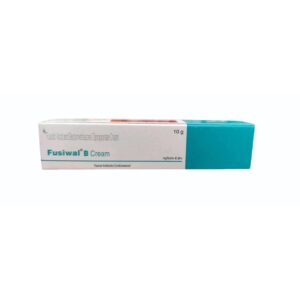BETAMETHASONE + FUSIDIC ACID
Betamethasone: Betamethasone is a synthetic corticosteroid drug used primarily as an anti-inflammatory medication. It is available as both a topical cream or ointment for skin conditions and as an injectable solution for various systemic conditions.
Mechanism of action: Betamethasone acts by binding to glucocorticoid receptors present in the target cells. This binding leads to the activation of certain genes and the suppression of others, resulting in potent anti-inflammatory and immunosuppressive effects. It reduces inflammation by inhibiting the production of various inflammatory mediators and suppressing the immune response.
Use: Betamethasone is commonly used to treat a variety of conditions including skin disorders such as eczema, psoriasis, dermatitis, and allergic reactions. It is also used in the management of allergic and inflammatory conditions affecting the airways, joints, and other organs. Additionally, it is used to stimulate lung development in preterm infants at risk for respiratory distress syndrome.
Dose: The dosage and administration of betamethasone vary depending on the condition being treated and the route of administration. For topical use, a thin layer of cream or ointment is applied to the affected area once or twice a day. For systemic administration, the dosage and frequency will be determined by the prescribing healthcare provider.
Side effects: Common side effects of betamethasone may include skin irritation, burning, itching, dryness, and redness at the application site. Prolonged use of betamethasone on large areas of the body or under occlusive dressings may lead to systemic side effects such as adrenal suppression, Cushing’s syndrome (characterized by weight gain, fatty deposits, moon face), increased susceptibility to infections, thinning of the skin, easy bruising, and delayed wound healing. Long-term use and sudden discontinuation of high doses can also lead to withdrawal symptoms. It is important to follow the prescribed dosage and duration of treatment to minimize the risk of adverse effects.
Fusidic Acid: Fusidic acid is an antibiotic medication commonly used to treat bacterial infections, particularly those caused by Staphylococcus aureus. It is available in various forms such as cream, ointment, and eye drops.
The mechanism of action of fusidic acid involves inhibiting bacterial protein synthesis by binding to the bacterial elongation factor G (EF-G). This prevents EF-G from carrying out its role in protein synthesis, ultimately leading to the inhibition of bacterial growth.
The dosage and administration of fusidic acid differ depending on the type of infection and the formulation being used. For example, when using fusidic acid cream or ointment for skin infections, it is typically applied to the affected area three to four times a day. As for eye drops, a typical dosage is one to two drops applied to the affected eye(s) twice a day.
Although fusidic acid is generally well-tolerated, it may have some side effects. Common side effects include skin irritation, itching, redness, and dryness at the application site. In some cases, allergic reactions may occur, with symptoms such as rash, swelling, and difficulty breathing. It is important to consult a healthcare professional if any severe or persistent side effects occur.
It is worth noting that since fusidic acid is primarily used as a topical medication, systemic side effects are rare. However, when taken orally, it can rarely cause gastrointestinal disturbances such as nausea, vomiting, and diarrhea.
As with any medication, it is essential to follow the prescribed dosage and complete the full course of treatment, even if symptoms improve before completion. Additionally, it is important to inform the healthcare provider about any existing medical conditions or medications being taken to ensure safe and effective use of fusidic acid.

